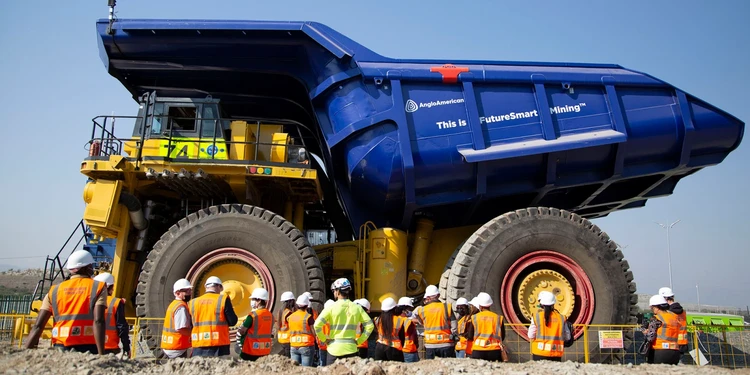Anglo’s new hydrogen vehicle: bad engineering, good marketing
An astonishingly expensive process for turning electricity into less electricity
Anglo American unveiled the world’s largest hydrogen-powered mine haul truck at the Mogalakwena mine in Limpopo on Friday. Photo: Felix Dlangamandla / Daily Maverick
Mine site vehicles present an unusually good case for solar energy for electric vehicles. A vehicle operating on a mine site operates for fixed, predictable hours which removes the uncertainty around energy storage to compensate for intermittent supply.
Mine site vehicles are also built on a gargantuan scale, which means that battery size is not the same challenge that it is for personal cars.
The biggest advantage, however, is that mine site vehicles operate within a fixed area, never far from their charging station. All the major obstacles to personal electric vehicles are absent and so a mine site is perhaps the best possible place to install a set of solar panels to power electric vehicles.
Anglo-American has gone a rather different route by unveiling a mammoth 210-ton zero-emissions truck set to run on hydrogen generated on-site using solar power. This is a rather convoluted design decision, because the overall process starts and ends with electricity, with hydrogen just an energy carrier for transfer and storage.
The thermal efficiency of electrolyzers (the processes for generating hydrogen) tends to be in the region of 70%, and hydrogen fuel cells seldom achieve higher than 60% efficiency. This puts the estimated overall efficiency of hydrogen at an abysmal 42%, with additional losses likely involved in compressing the hydrogen and leakage.
Hydrogen is more or less the world record holder for substances least likely to stay where you put them, as it is capable of permeating even through solid steel. This same property also makes it remarkably corrosive, demanding that highly specialised steel mixes be used, or that all components are regularly rotated out of use for heat treatment.
The presence of hydrogen on a site also changes its safety profile entirely, as it has a broader explosive range than any conventional fuels and, in order to match the energy density of a lithium-ion battery, has to be compressed to extreme pressures, typically on the order of 300 bar but sometimes as high as 700 bar. The latter is equivalent to the pressure underneath a stack of bricks 3.5km tall, or something like a full capacity Ellis Park crowd all crammed onto a single seat.
In short, the hydrogen round trip, here, is an astonishingly expensive process for turning electricity into less electricity. If that entire process were removed and replaced with a sizeable charging cable, two or possibly three of the same trucks could be powered by the same solar setup, and the cost of the entire project would be reduced dramatically.
This overall design represents dreadful engineering decision-making and one has to explore other motives that might be behind it. Of note is that Anglo-American’s primary business is in mining Platinum-Group Metals, the primary use of which is in catalytic converters on conventional-fuel cars. A global switch to electric cars presents an existential threat to the company. By contrast, a hydrogen economy using platinum in both the electrolysers and the fuel cells, would guarantee Anglo a sizeable new market.
The project has drawn broad political support, with President Cyril Ramaphosa lauding it as a step toward a hydrogen economy.
While this project could have been a landmark in our energy transition, instead it must serve as a warning of the worst possibilities for what our energy transition could be.
© 2022 GroundUp. This article is licensed under a Creative Commons Attribution-NoDerivatives 4.0 International License.
You may republish this article, so long as you credit the authors and GroundUp, and do not change the text. Please include a link back to the original article.
We put an invisible pixel in the article so that we can count traffic to republishers. All analytics tools are solely on our servers. We do not give our logs to any third party. Logs are deleted after two weeks. We do not use any IP address identifying information except to count regional traffic. We are solely interested in counting hits, not tracking users. If you republish, please do not delete the invisible pixel.



